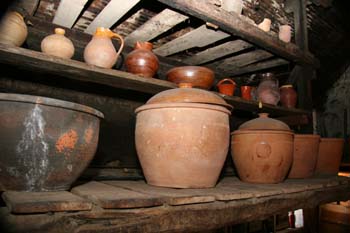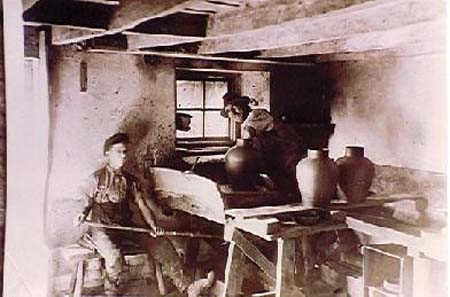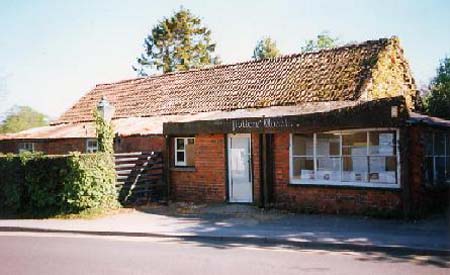|
Background.
Verwood is situated in an area
of many clay seams, which supported numerous potteries and 5
brickworks. The date of construction is uncertain. The site
is evident on the Tithe Map of 1847 and the recent
archaeological dig, manganese, glazed pottery from the 18th
century was discovered.
The Drying Shed (Now the VHHC
Museum).
 The drying shed
building is of cob construction, with foundations and floor
of brick. The cob walls were built using clay mixed with
chopped heather, furze and manure and put between boarding
about 3 feet high. When that dried, the boards were moved up
and another layer added. These are called rearings and can
still be seen clearly. The drying shed
building is of cob construction, with foundations and floor
of brick. The cob walls were built using clay mixed with
chopped heather, furze and manure and put between boarding
about 3 feet high. When that dried, the boards were moved up
and another layer added. These are called rearings and can
still be seen clearly.
The building has two stories.
The roof is tiled with a lining of heather supported by
battens. The exciting feature of the
building is that it still has the original roof with charred
battens and the drying racks in the upper storey remain.
Clay for the Pottery.
Much of the clay dug in the
village was yellow. Some clay was dug nearby, from the
Ferrett Green site and the eastern side of the pottery. Blue
clay was brought by horse A cart A later steam engine from Holwell, near the Heavy Horse Centre. In latter years, blue
clay came from Corfe Mullen. The yellow clay was used for
flower pots, as it was porous and blue clay for pitchers and
larger vessels, due to its strength.
Clay was brought into the
building by barrow and put to soak in water, in a pit (now
under the boards). It was then dug out and stacked against
an inside wall, the remains of which are evident.
The clay was then mixed with
sand and water by a man using his bare feet, keeping himself
upright using a pole. The
clay was then mixed with sand and water by a man using his
bare feet, keeping himself upright using a pole. The clay
was ready for making.
This system was also used in the
brick lean-to, now demolished. The old brick floor and soak
pit can be seen in front of the restored building.
Potting.
 Two types of wheel were used. To
enable the potter to create his pot, his assistant, sitting
on an upturned pot, pushed and pulled a pole which, with a
simple mechanism, turned the wheel. The other type
functioned by an assistant turning a handle, similar to the
mechanism of a bicycle, which turned the wheel. Two types of wheel were used. To
enable the potter to create his pot, his assistant, sitting
on an upturned pot, pushed and pulled a pole which, with a
simple mechanism, turned the wheel. The other type
functioned by an assistant turning a handle, similar to the
mechanism of a bicycle, which turned the wheel.
Pots were created & dried
outside when the weather was suitable and in the drying shed
when wet.
Kiln.
On the site of April Cottage,
next door, was a large kiln mound containing two kiln
chambers. The kilns were stacked from the top of the mound,
the operators having to carry the pots up some steps and
then down a ladder inside to stack from the base of the
kiln. Firing took place for three days and nights.
Other History and uses of the
Site.
 There was a shop on this site, but other ware,
together with besom brooms were taken by higglers with their
horses and wagons as far afield as
Devon
and
Basingstoke
. There was a shop on this site, but other ware,
together with besom brooms were taken by higglers with their
horses and wagons as far afield as
Devon
and
Basingstoke
.
By 1920, due to the development
of enamel ware, the demand for Verwood ware declined. Fred
Fry took over with hopes to continue and in 1925, Robert
Thorne Ltd bought the site.
During the Second World War, Boy
Scout meetings were held in the room above the corridor and
toilets for Ladies and the Disabled.
The Crossroads Pottery was the
last remaining of the numerous primitive potteries in the
area and it eventually closing in 1952.
Since then it has been variously
rented for a number of uses including a Tea Shop and a
Hardware Store (The Potters Wheel) which eventually closed
in 1992. The owners, Robert Thorne Ltd. then donated the
Potters Wheel building to the town. Eventually after
fundraising and much work it opened in 2003 as the Verwood
Heathlands Heritage Centre.
|